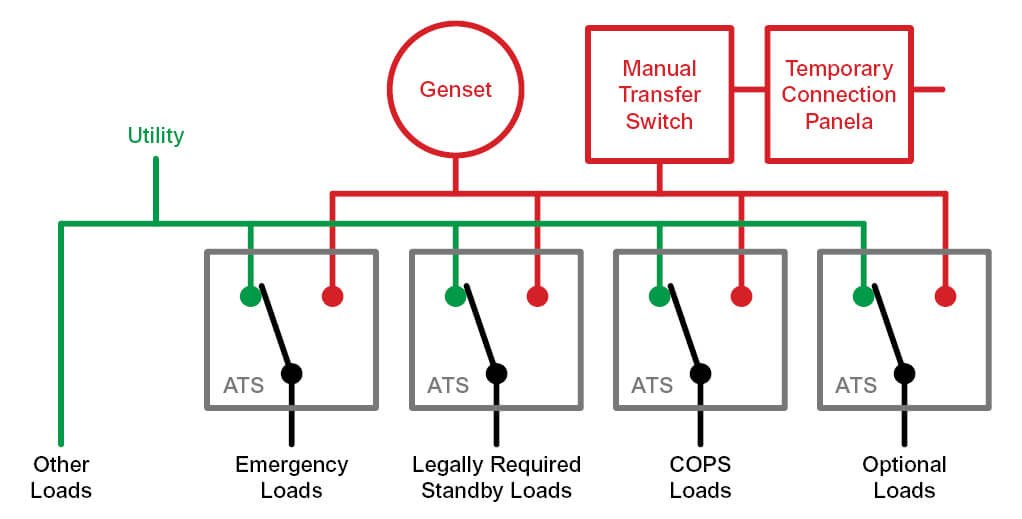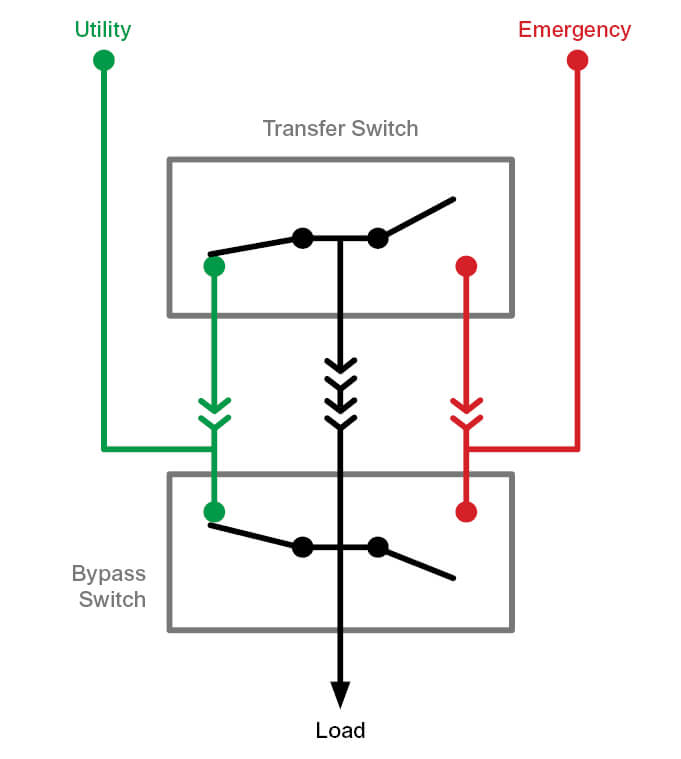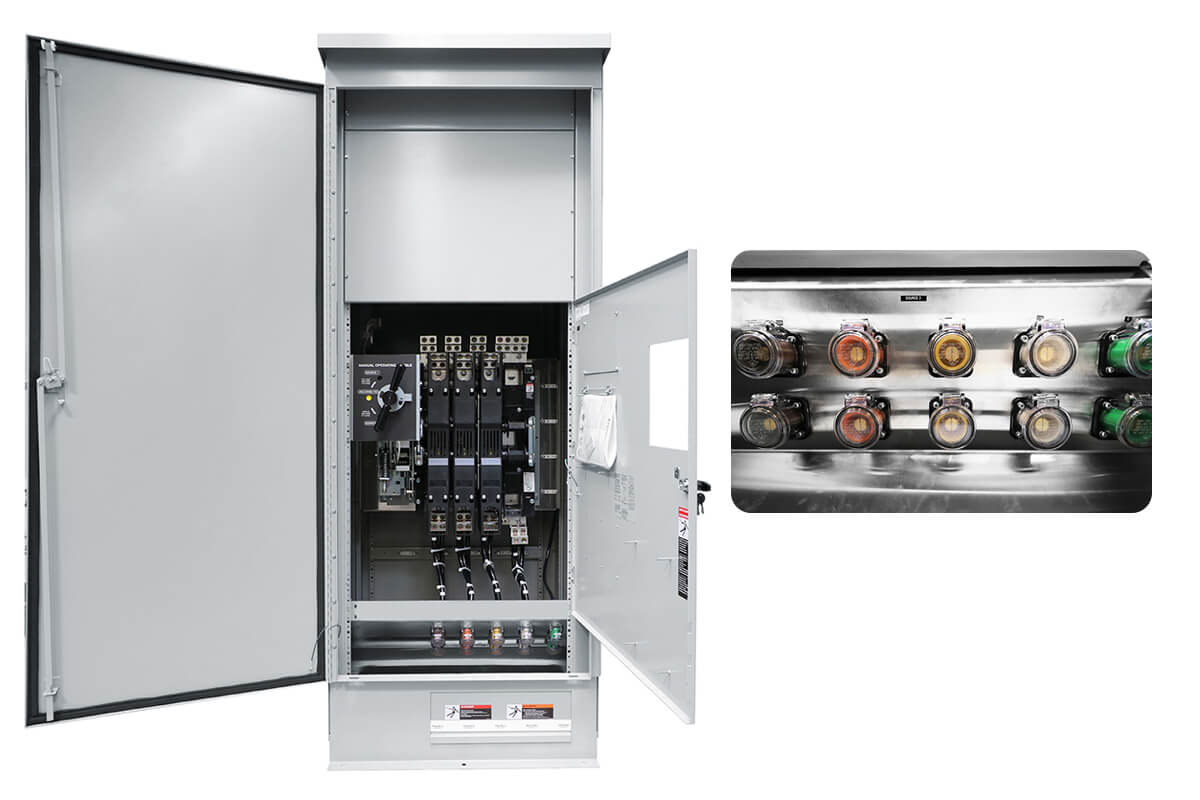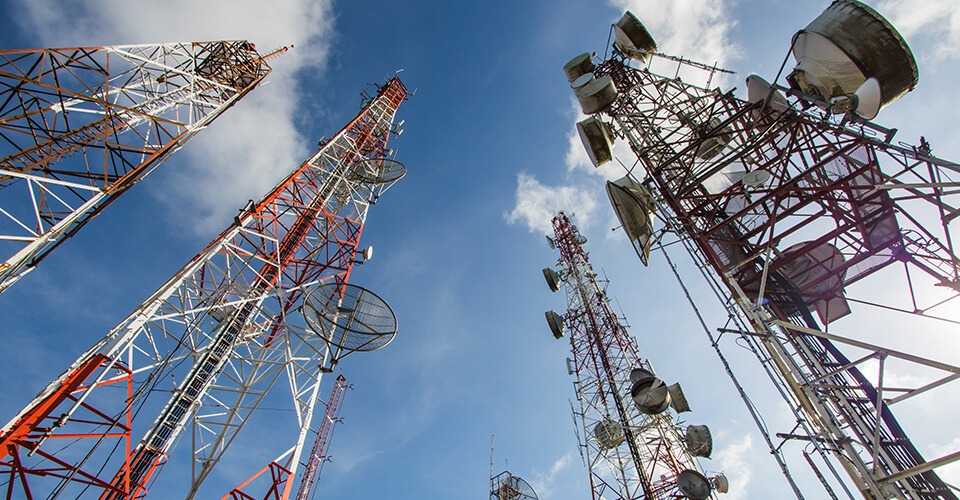Telecommunication facilities play essential functions in the modern economy and emergency response by offering voice, video, internet, and other communication services. As an industry with mission-critical operations, these companies require a dependable source of power, especially in situations when equipment must be taken offline for maintenance. This article will examine how facilities providing public safety and security can ensure a steady flow of backup energy when they are most likely to experience utility power outages.
COPS Requirement Summary
Article 708 of the
National Electrical Code® (NEC®) sets forth requirements for Critical Operations Power Systems (COPS). These are power systems in facilities needed to maintain public safety or national security. Air traffic control towers and police, fire, and ambulance stations are just a few examples of the facilities affected by Article 708.
In addition to other NEC requirements for Life-Safety, Legally Required and Optional loads (respectively contained in Articles 700, 701, and 702), Article 708 sets forth certain additional requirements for COPS. These include completing a risk assessment of hazards that could impact operations as well as the development of a plan to mitigate those risks, plus requirements for performing and documenting maintenance and service. Mitigating the risks and effects of electrical power outages is central to providing continuous safety and security services. Figure 1 below shows a configuration for a backup power system at a COPS facility.
 Figure 1
Figure 1
Maintaining Backup Capability During Service Events
Backup power equipment needs periodic service to ensure equipment condition and readiness for use. This typically requires taking equipment such as generators and transfer switches out-of-service. Where that equipment is the only pathway to supplying COPS loads, a service event would make backup power unavailable for mission-critical functions until the equipment is returned to service.
If a utility power outage occurred during a service event, then a facility will be without electrical power needed to fulfil its mission until either the utility service or the backup power system is functionally restored. When such outages occur at an ordinary business, such as at a commercial dry goods warehouse during a severe storm, the impact to the public is typically indirect. If the same outage occurs at a COPS facility, it could interrupt essential operations that place the health, safety, and security of people at risk.
In the figure above, a facility’s COPS loads are served by a single generator and a single automatic transfer switch. Both units require periodic maintenance that will render them unavailable during their respective service events. Either unit could also require unscheduled repairs that produce the same circumstance.
Requirement for Bypass Transfer Switches at COPS Facilities
The design of
Bypass Isolation Automatic Transfer Switches enables operators to direct current through a secondary transfer mechanism while the primary mechanism is isolated for inspection, service, and repair. When placed in bypass mode, transfer functionality is maintained during service events. If a utility outage occurs during equipment service, loads can still be transferred to and served by an alternate power source. A diagram of a bypass isolation transfer switch is shown in Figure 2.
 Figure 2
Figure 2
Because of the critical nature of their missions, loads served by a single transfer switch must use a bypass isolation transfer switch or provide redundant transfer equipment. This need is reflected in Article 700 and Article 708 of the 2020 NEC:
700.5(D) Redundant Transfer Equipment
If equipment loads are supplied by a single feeder, the emergency power system shall include redundant transfer equipment or a bypass isolation transfer switch to facilitate maintenance as required in 700.3(C) without jeopardizing continuity of power
708.24(D) Redundant Transfer Equipment
If COPS loads are supplied by a single feeder, the COPS shall include redundant transfer equipment or a bypass isolation transfer switch to facilitate maintenance as required in 708.6(C) without jeopardizing continuity of power.
Requirement for a Temporary Power Source at COPS Facilities
Generators also require periodic maintenance that makes them unavailable during service events. For example, if a facility regulated by NEC Article 700 provides backup power to life safety loads from a single generator, connections for a temporary power source must be provided according to Article 700.3(F):
700.3(F) Temporary Source of Power for Maintenance or Repair of the Alternate Source of Power.
If the emergency system relies on a single alternate source of power, which will be disabled for maintenance or repair, the emergency system shall include permanent switching means to connect a portable or temporary alternate source of power that shall be available for the duration of the maintenance or repair.
Similarly, COPS loads require a “backup-for-the-backup”. If a COPS facility cannot be supplied with sufficient electrical power when one of its generators (often its only generator) is taken offline for service, essential operations would be disrupted, placing the health, safety or security of people at risk. For this reason, NEC Article 708 requires providing COPS with capability to provide adequate backup power if an outage were to occur during generator service:
708.20(F)(6) Means for Connecting Portable or Vehicle-Mounted Generator.
Where the COPS is supplied by a single generator, a means to connect a portable or vehicle-mounted generator shall be provided.
Article 708 effectively requires that facilities have either (1) sufficient redundant generators to supply COPS loads with one generator offline, or (2) a means of temporarily connecting sufficient generation capacity. The latter can be accomplished by equipping backup power systems with an additional manual transfer switch and provisions for temporary connection. Connectors can be incorporated either into a dedicated panel or integrated with a manual transfer switch. An example configuration is shown within Figure 1. An ASCO Power Technologies
Manual Transfer Switch with Integrated Quick Connects is shown in Figure 3.
 Figure 3: An ASCO SERIES 300 Manual Transfer Switch with Intergrated Quick Connects
Figure 3: An ASCO SERIES 300 Manual Transfer Switch with Intergrated Quick Connects
The cost of this solution is typically lower than providing a permanent redundant generator. For more information about providing temporary generation capacity, see the ASCO Power Technologies Technical Brief entitled
Temporary Connections for Generators and Load Banks.
Summary
Communications are a vital element that supports businesses, emergency services, and the government. Over the last quarter-century, this industry has progressed from primarily providing voice service to a diversified, connected, and competitive industry involving data, email, and wireless communication. With the increasing independence on these services and the rise of
5G, power availability for telecommunication companies has never been more critical.
The National Electrical Code (NEC) Article 708 outlines the necessary measures to be taken for protection of safety and security personnel in facilities that are involved in public safety or national security.
It is necessary to ensure that backup equipment is always available when any power backup equipment needs servicing. This can be done through:
- The usage of Bypass Isolation Transfer Switches which allows equipment inspection, testing, and maintenance without interrupting power flow.
- The usage of a manual transfer switch with a power panel for temporary power sources simplifies equipment maintenance and improves redundancy.





